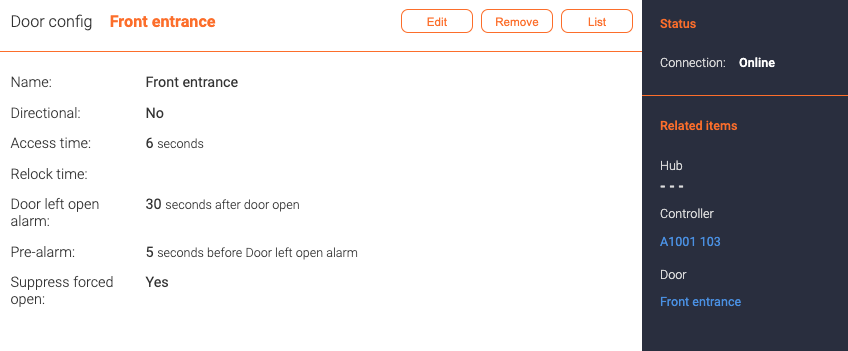Door configs: Difference between revisions
Jump to navigation
Jump to search
Telcredstaff (talk | contribs) |
Telcredstaff (talk | contribs) No edit summary |
||
| Line 1: | Line 1: | ||
== Settings == |
|||
[[File:Door-config.png|Door config details]] |
[[File:Door-config.png|Door config details]] |
||
| Line 13: | Line 12: | ||
After having created a door config, it can be linked to the right controller on the [[Controllers|controller]] page. |
After having created a door config, it can be linked to the right controller on the [[Controllers|controller]] page. |
||
When a door config is created, a [[Doors|door]] with the same name is automatically created. The door contains additional settings and actions which are relevant in day-to-day administration of the system. |
|||
Revision as of 10:39, 7 September 2020
To create a new door in Telcred Access Manager, it is first necessary to create a door config. The door config contains the door's name and some technical parameters, which are typically set by the installer/integrator:
- Name. Should be something meaningful to both the administrator and the end users.
- Directional. Directional doors are explained here. The default is no.
- Access time. This is the time the lock stays unlocked after a credential has been accepted by the reader.
- Open too long alarm. After this time the alert Door left open will be generated and the reader will indicate an alarm.
- Pre-alarm. The number of seconds before Open too long time that the reader will warn the user to close the door.
- Suppress forced open. With this setting, no Door forced open alerts will be generated. This can be relevant where the door is equipped and configured with a door monitor but opened manually from the inside (as opposed to with a REX device). Note: If the door has a reader, the reader will still indicate Door forced open even though it is ignored in Telcred Access Manager.
After having created a door config, it can be linked to the right controller on the controller page.
When a door config is created, a door with the same name is automatically created. The door contains additional settings and actions which are relevant in day-to-day administration of the system.
